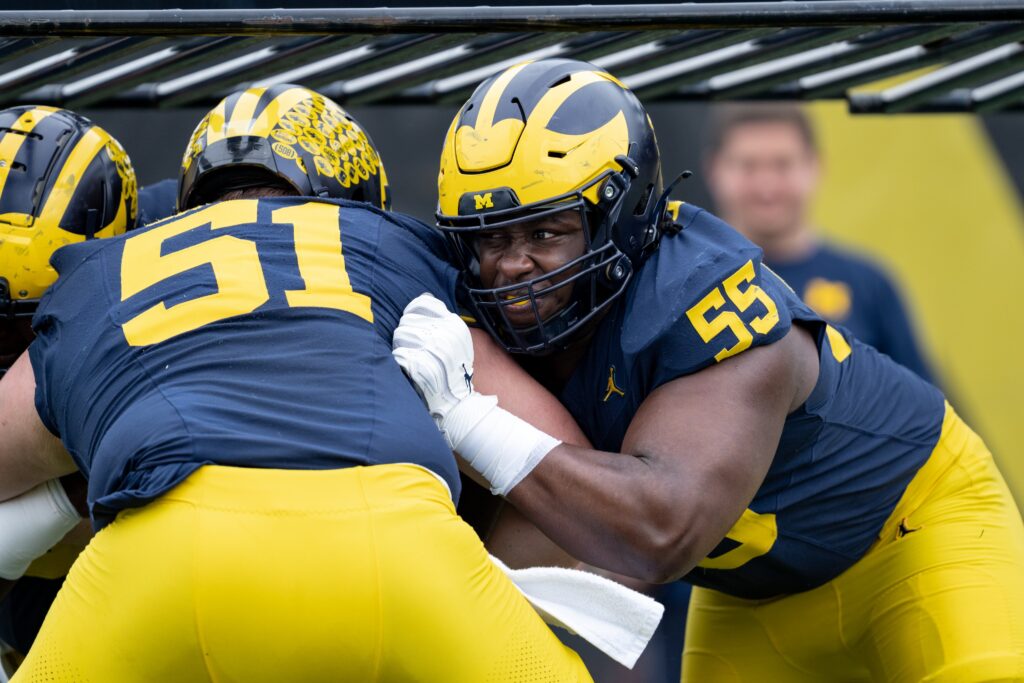
Michigan offensive lineman Nathan Efobi makes a block during pregame warmups.
The Big Ten Conference, long revered for its gritty, physical style of football, is facing an unprecedented challenge in recruiting top-tier offensive linemen. Despite the success of programs like Michigan and Ohio State, which have historically developed some of the nation’s best offensive lines, the conference is struggling to lure elite talent from across the country. This issue isn’t isolated to just one or two programs; it’s a widespread problem that threatens the Big Ten’s ability to compete at the highest levels of college football.
Michigan’s Success and Struggles
Michigan, one of the flagship programs of the Big Ten, has seen remarkable success in recent years, particularly with its offensive line. The Wolverines have won the prestigious Joe Moore Award, given to the nation’s best offensive line unit, twice in the last three years. This accolade underscores Michigan’s reputation as a premier destination for offensive line development. Yet, even with this success, Michigan is struggling to secure commitments from top offensive linemen in the class of 2025.
As Jeremy Birmingham, a recruiting expert, pointed out, Michigan has offered scholarships to 44 offensive linemen in the 2025 class but has only secured two commitments. One of these is Avery Gatch, who hails from Michigan, and the other is Kaden Strahorn, whose family roots are in Detroit. Birmingham’s assessment highlights the broader issue: even Michigan, with its strong track record and national championship pedigree, is finding it difficult to attract offensive linemen from outside its regional footprint.
Birmingham also notes the uncertainty surrounding Michigan’s pursuit of Andrew Babola, a five-star offensive tackle from Kansas. Despite Michigan being in a strong position, there is no guarantee that Babola will choose the Wolverines. As Birmingham observes, “He could go anywhere he wants,” emphasizing the challenge Big Ten programs face in convincing elite prospects to choose their schools over those in other conferences, particularly the SEC.
The Broader Big Ten Dilemma
This recruiting challenge is not limited to Michigan. Ohio State, another powerhouse in the Big Ten, is encountering similar difficulties. Ohio State’s struggles are particularly concerning given the program’s national reputation and consistent success on the field. As Birmingham puts it, “This is not just an Ohio State problem; it is a Big Ten problem that is continuing to be exacerbated.”
The issue is further highlighted by the case of Michael Carroll, the best offensive lineman in Pennsylvania, who has committed to Alabama rather than staying in the Big Ten. Penn State, which has a strong reputation for developing linemen and traditionally does well recruiting within its region, could not keep Carroll from leaving the conference.
Birmingham’s insight sheds light on the root of the problem: the perception that the SEC is the premier destination for players who want to develop and compete at the highest level. This perception is not just damaging to Ohio State or Michigan but to the entire Big Ten. As Birmingham aptly states, “This is a Big Ten problem,” one that needs to be addressed if the conference hopes to remain competitive on the national stage.
Looking Forward
As the Big Ten continues to expand and increase its presence in the college football landscape, the hope is that this perception will begin to shift. The addition of high-profile programs like USC and UCLA could help elevate the conference’s national profile and make it more attractive to top recruits. However, as Birmingham points out, the belief that players need to go to the SEC to be developed into NFL-caliber talent must be challenged and changed.
For now, the Big Ten’s struggle to recruit elite offensive linemen remains a significant issue. Despite the success of programs like Michigan and Ohio State, the conference as a whole must find ways to overcome these recruiting challenges. Whether through expanding their recruiting reach, changing perceptions, or capitalizing on the Big Ten’s growth, something has to give if the Big Ten hopes to maintain its status as one of college football’s premier conferences.






[…] The Big Ten’s Offensive Line Recruiting Struggles: A Conference-Wide Issue […]
[…] The Big Ten’s Offensive Line Recruiting Struggles: A Conference-Wide Issue […]